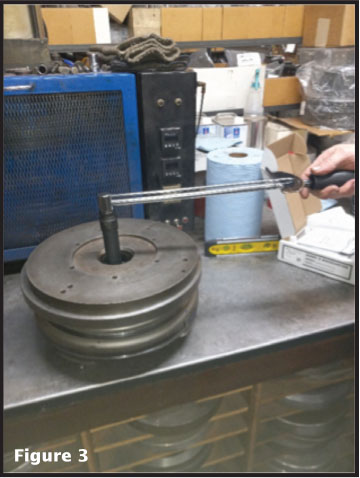
10R80 – Part 1
February 4, 20236F35 Piston Rivets – TEST TEST
September 12, 2023Last month we looked at the clutch / turbine assembly of a Ford 10R80 converter, code HL3P-AD. This month we will explore the unique dampener assembly in this converter.
The dampener has a small Belleville spring in it that cannot be compressed by hand. A little help from an Arbor Press indicates about 0.030” (0.76mm) of movement. Six upright fingers were revealed on the Belleville Spring after disassembling the dampener assembly. They are chamfered on the ends and there appears to be a corresponding chamfer on the center plate of the dampener (Figures 1 and 2). This effectively makes the overall height of the turbine/clutch variable when measured from the friction to the thrust surface of the center plate; where it contacts the cover washer, depending on the load being placed on the dampener. When force is applied to the turbine and the input shaft resists rotation, the dampener “winds up” allowing the center plate to slide down the ramps; providing the clutch clearance with supporting hydraulic force, releasing the clutch. When the dampener winds up in the opposite direction, such as during an engine braking condition, it will force the center plate up the ramps; wedging the turbine into the impeller. The center plate has a 0.100” (2.54mm) range of motion, with the at-rest position being around 0.030” (0.76mm) from the bottom. This leaves 0.070” (1.78mm) of travel upwards. So, there is the clutch release travel, but the other function the Belleville spring serves is it helps apply the clutch by mechanical force under engine braking conditions.
Setting the pre-load/turning resistance will be problematic and it will probably take some trial and error before identifying a good set of parameters. The initial pre-load will need heavy consideration to allow for the weld shrinkage that will impact the desired turning resistance. The shops with ATI style converter welders could simply adjust the air pressure on the air rams that operate the faceplate ram and do the math to determine what air pressure is needed to obtain the desired pre-load. Those shops with TCRS style welders might be able to set the preload by bringing the quill down to the point the clutch is bottomed out on the cover, and then advancing the quill a few thousands of an inch to obtain the desired pre-load. One suggestion is to check the turbine turning resistance after welding and the converter has had a chance to cool.
In addition, the input splines are in the dampener assembly and move independently of the turbine (Figure 3). The turbine is centered by a Teflon lined bushing with an I.D. slightly larger than the major diameter of the input splines (Figure 4). A presumption is this bushing not only keeps the turbine centered, but it also acts as a seal to separate converter charge pressure and clutch apply oil; making the bushing important for proper converter function. Care should be taken when checking the clutch turning resistance with snap ring pliers or a “dummy shaft”, so as not to damage the bushing. A balancing shaft will have to support both the turbine and the input splines, as well as the stator, to keep all the internal components concentric to the converter center line. It may also be better to install the converter with the transmission vertical, as most often do with 6T70 converters, to avoid damaging the turbine bushing.
The cover bushing that supports the input spline/center plate is what I would call a “top hat” bushing that acts both as a bushing and a thrust surface for the input spline. We have seen these before in old Datsun/Jatco converters (Figure 5). This could make fine tuning the overall height of these converters a little more difficult. The last item identified was the “H-shaped” spacers used to rivet the dampener assembly together (Figure 6). It is similar to the ones used in the 66RFE dampeners. Is this becoming a trend in converter design?
I am confident we will adapt to this new breed of converter; just as we have had to do captive clutches in the past few years. Ford and General Motors are planning to build millions of these units, so I think it is safe to assume we need to learn all we can about these units today.
Brad Gilbert
TCRA Technical Coordinator








